What if you could generate high-quality blog posts in minutes instead of hours? Imagine the time saved and the content produced. In today's fast-paced digital landscape, marketers and content creators face immense pressure to deliver engaging content consistently. The struggle to maintain originality and adhere to tight deadlines can lead to burnout and reduced productivity.
This is where AI blog writers come into play—powerful tools designed to streamline the content creation process, allowing users to generate relevant, high-quality articles efficiently. With AI blog writers, marketers can focus on strategy and creativity while letting the technology handle the heavy lifting. Below, we've curated a list of the top AI blog writers to help you enhance your content creation process and elevate your content strategy.
Best for: Marketing professionals and businesses aiming to enhance content strategy.
IndexPilot stands out as a leading AI blog writer that optimizes content for SEO and engagement.
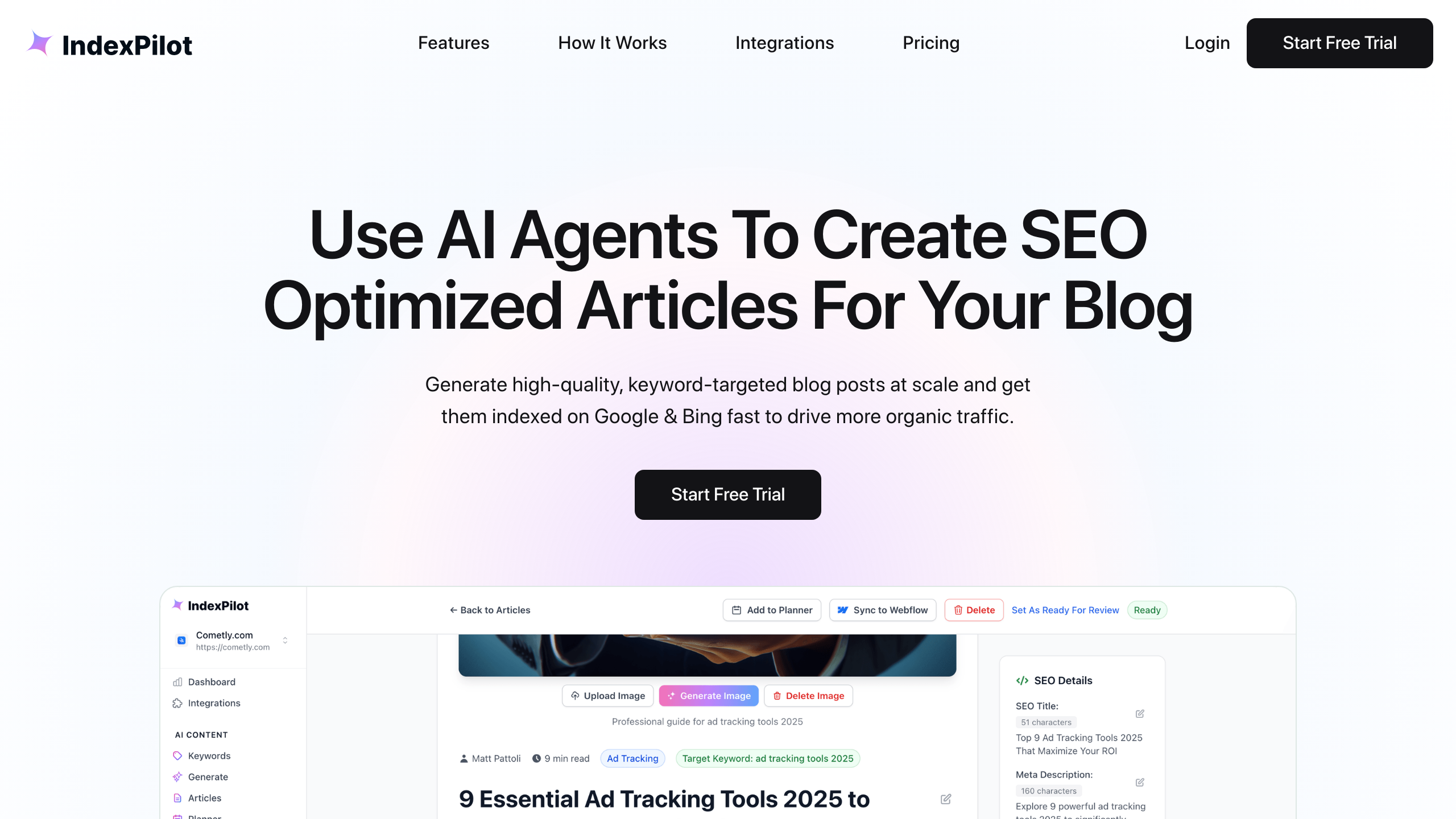
1. AI-generated drafts focused on target keywords: IndexPilot is adept at ensuring that your content is meticulously aligned with the specific keywords your audience is actively searching for. This feature not only increases the visibility of your articles but also enhances their relevance in search engine results. For instance, by inputting a keyword like "digital marketing strategies," IndexPilot can generate a comprehensive draft that incorporates this term naturally throughout the text, maximizing your chances of ranking higher in search results. Furthermore, this targeted approach helps in attracting the right audience, ultimately leading to increased engagement and conversion rates.
2. Ready-to-use templates for various content types: One of the standout features of IndexPilot is its array of ready-to-use templates designed for a multitude of content forms. Whether you need to create listicles, how-to guides, or detailed explainers, IndexPilot provides a structured framework that simplifies the writing process. For example, if you're tasked with writing a listicle about "Top 10 Marketing Tools," you can select a template that outlines the necessary sections, such as introduction, tool descriptions, and conclusion. This not only saves time but also ensures that your content is well-organized and engaging from the get-go.
3. Built-in SEO optimization tools: With IndexPilot, SEO is seamlessly integrated into your content creation process. The platform offers intelligent suggestions for internal linking, which enhances the connectivity of your articles within your website. For example, if your article discusses "content marketing," IndexPilot might suggest linking to another article on your site about "SEO strategies for content marketing." This not only improves user navigation but also boosts your site's overall SEO performance by encouraging longer session durations. Additionally, IndexPilot generates optimized titles, meta descriptions, and slugs automatically, providing you with a solid SEO foundation in mere seconds. You can then refine these elements directly within the editor, ensuring your final output is polished and ready for both search engines and readers.
By leveraging these features, IndexPilot significantly streamlines the content creation process. Marketers and content creators can draft multiple articles with full editorial control, allowing them to publish anywhere from three to eight optimized posts daily without the extra effort typically associated with content generation. This means more time can be devoted to strategic planning and creative brainstorming, which are crucial for standing out in today’s competitive digital landscape.
Pros: IndexPilot is known for its user-friendly interface and the intelligent suggestions it offers for internal linking.
Cons: Some users may experience a learning curve when accessing its advanced features.
For instance, IndexPilot's capabilities include AI-powered drafts built around your target keywords, which can significantly enhance your content strategy.
Best for: Freelancers and small business owners seeking efficient content solutions.

Jasper is a versatile AI tool for blog writing that combines ease of use with high-quality output.
AI writing tools are no longer a novelty — they’ve become an essential part of how marketers, SaaS teams, and agencies create content at scale. Among the most well-known names in the space is Jasper, an AI assistant designed to make blog writing faster and easier. But with so many tools on the market, how does Jasper really stack up, and is it the best option for your content strategy?
Jasper is an AI-powered content platform built for marketers, bloggers, and businesses that need high-volume, high-quality writing. The software leverages advanced natural language processing to create content that flows naturally and sounds human. Its biggest draw is the balance between ease of use and the ability to generate blog posts, ad copy, emails, and other formats quickly.
The platform has grown popular because it doesn’t feel intimidating. Whether you’re a solo blogger or part of a marketing team, Jasper’s interface is designed to get you writing immediately without a steep learning curve.
Pros
Cons
Jasper is strong, but it’s far from the only player in the AI content game.
Jasper is ideal for:
If your main goal is scaling blog content with SEO in mind, Jasper can work, but you may also want to look at alternatives like IndexPilot that focus on ranking, indexing, and automation.
Best for: Social media managers and marketers focusing on rapid content delivery.
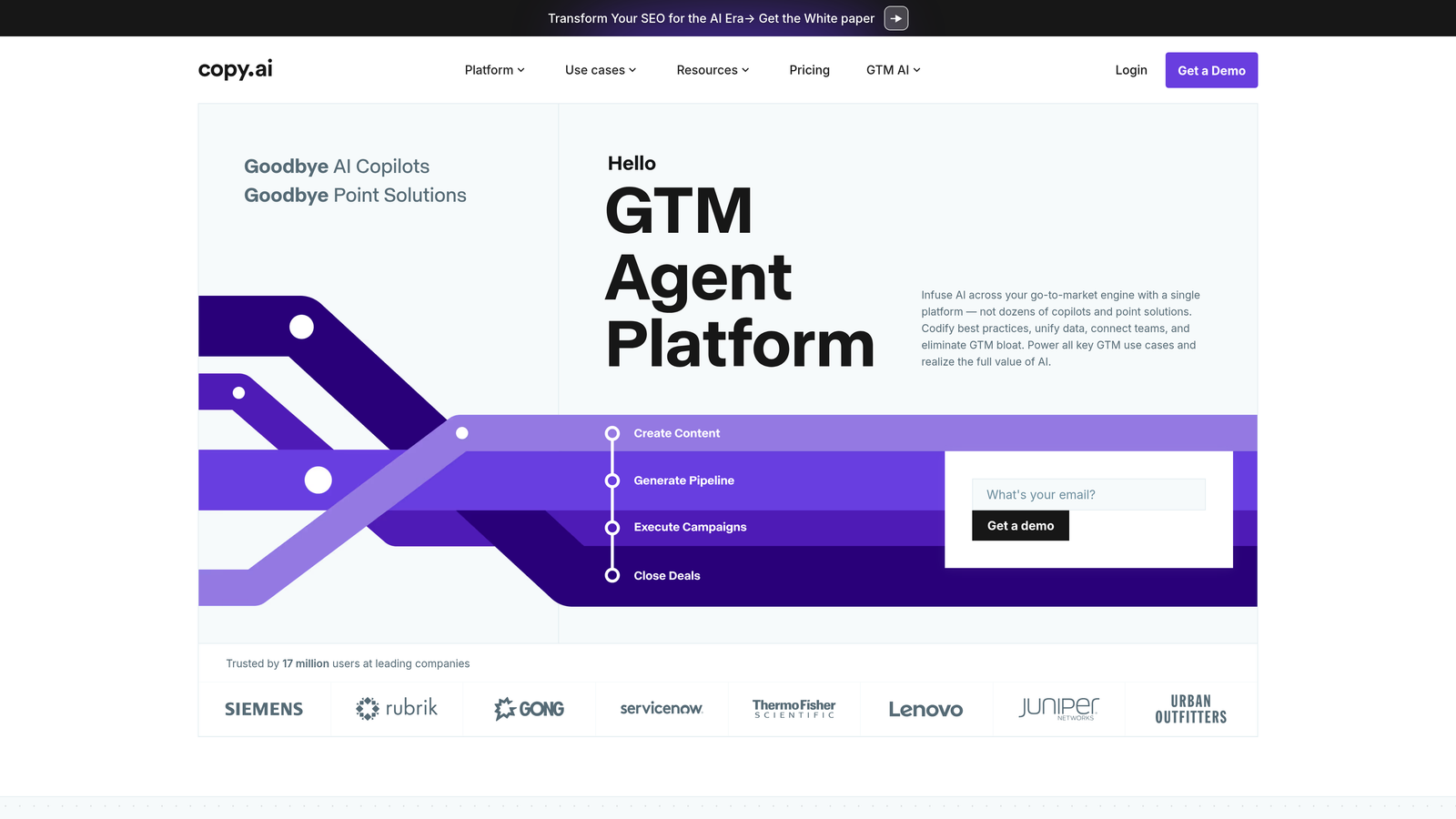
Copy.ai excels in fast content generation, making it a favorite among marketers.
In the crowded world of AI writing tools, Copy.ai has carved out a reputation as one of the fastest and easiest options for generating marketing copy. Where some platforms focus on depth and customization, Copy.ai shines when speed and simplicity matter most. For marketers juggling multiple campaigns or small businesses that need quick turnarounds, Copy.ai can be a valuable asset. But how does it really perform for blog writing and content strategy compared to alternatives like Jasper, Writesonic, or IndexPilot?
Copy.ai is an AI-powered writing assistant designed to help marketers, entrepreneurs, and agencies create written content in minutes. Its biggest selling point is speed — users can generate ad copy, product descriptions, blog outlines, and even long-form drafts much faster than writing manually.
Instead of being overloaded with complex features, Copy.ai focuses on giving you clear, usable outputs quickly. That makes it particularly appealing to time-strapped teams or beginners who don’t want to climb a steep learning curve.
Pros
Cons
Best for: Agencies and larger teams needing robust content solutions.
Writesonic is a powerful AI writing assistant designed for comprehensive content creation.
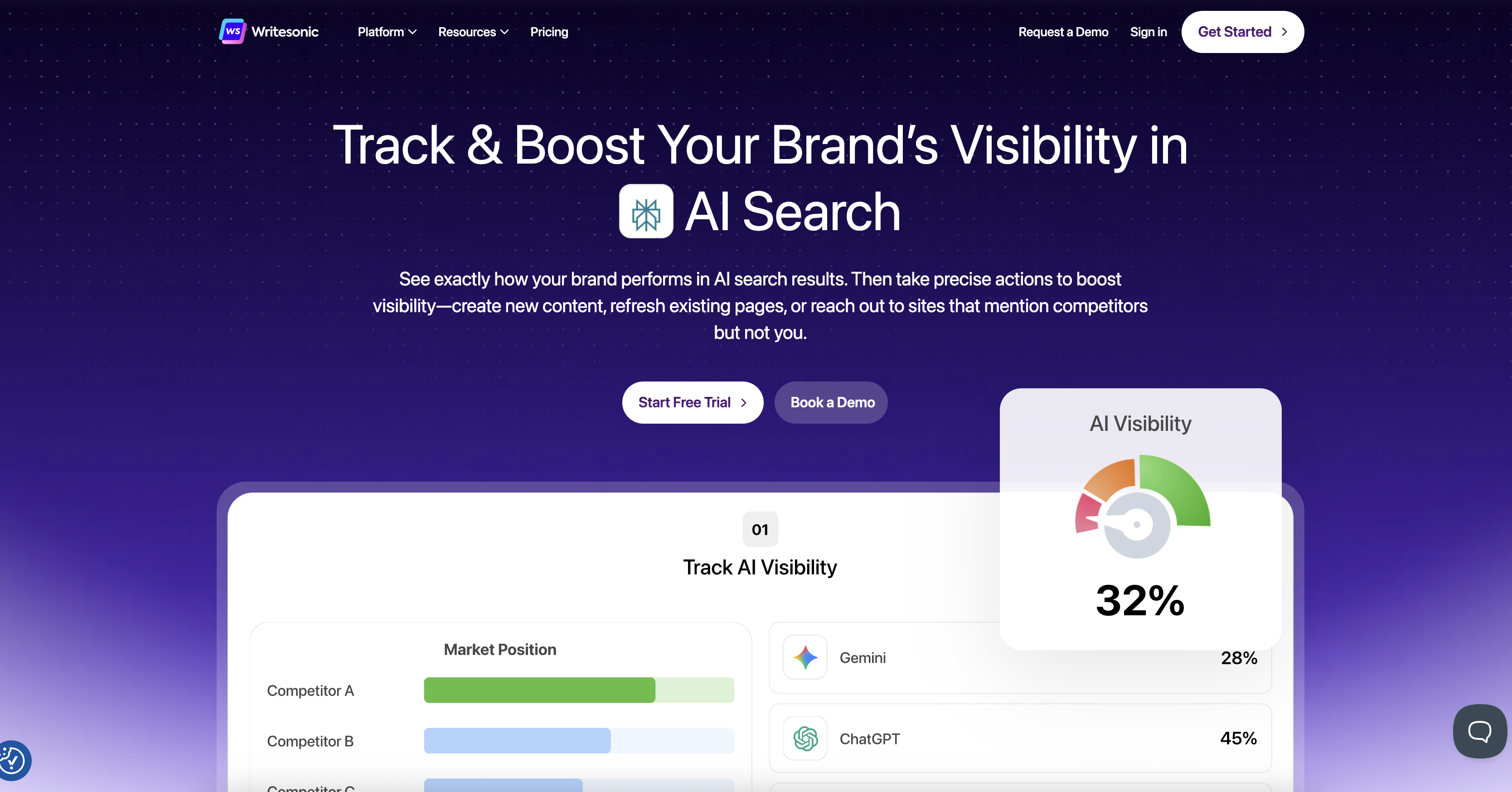
As AI writing tools continue to evolve, some platforms stand out for their ability to go beyond quick drafts and short snippets. Writesonic has positioned itself as one of the more advanced options, offering long-form content generation, optimization features, and a wide range of tools to support marketers, bloggers, and businesses. But with more features comes added complexity — so is Writesonic worth it for your team?
Writesonic is an AI-powered writing platform that appeals to users who need more than just quick headlines or blog outlines. Unlike lighter tools that focus on speed, Writesonic aims to deliver in-depth, well-structured articles and offers features designed to optimize that content for different platforms. For marketers who need blog posts, ad copy, and even landing pages, Writesonic provides a versatile set of capabilities.
The platform is also known for being more flexible than tools like Copy.ai. While that makes it powerful, it also means new users may face a steeper learning curve.
Pros
Cons
Best for: Budget-conscious creators looking for effective solutions.

Not every business needs a complex, feature-heavy AI writing platform. For many, affordability and ease of use matter more than advanced customization. That’s where Rytr shines. Positioned as one of the most cost-effective AI writing tools on the market, Rytr has become a favorite for small businesses, solo creators, and marketers looking for a simple way to produce consistent content. But how well does it perform compared to Jasper, Copy.ai, and Writesonic?
Rytr is an AI writing assistant designed with accessibility in mind. Its appeal lies in being both budget-friendly and versatile, making it a strong option for individuals or teams that don’t need enterprise-level tools. Whether you want to create casual blog posts, formal articles, emails, or social media updates, Rytr provides templates and tone settings that make the process straightforward.
Unlike some platforms that feel overwhelming, Rytr’s strength is its simplicity. You can sign up, choose a use case, enter a prompt, and generate content within minutes. This makes it especially attractive to users who are new to AI writing.
Pros
Cons
Best for: Content teams needing quick edits and revisions.

Wordtune focuses on enhancing existing content rather than generating original pieces.
While many AI platforms focus on generating new content from scratch, Wordtune takes a different approach. Rather than being an idea-to-draft tool, Wordtune is designed to enhance and refine existing content, making writing clearer, more engaging, and easier to read. For marketers, students, and teams who already produce content but want to improve its quality, Wordtune acts more like a digital editor than a ghostwriter.
Wordtune is an AI-powered writing assistant built to improve the quality of your writing. Instead of spitting out entire blog posts like Jasper or Writesonic, Wordtune helps users rephrase sentences, adjust tone, and improve clarity. It’s particularly useful for editing existing drafts, tightening copy, or making content more engaging.
The platform also comes with collaboration features, allowing teams to refine documents together. This makes it a strong fit for professional environments where multiple stakeholders need to polish content before publishing.
Pros
Cons
Best for: Anyone looking to enhance their writing quality.

Grammarly is more than just a writing assistant; it's a comprehensive tool for improving writing quality.
When most people think of AI writing tools, they picture platforms that generate new blog posts or ad copy. But not every marketer or business needs content creation — sometimes the bigger need is ensuring what you’ve already written is clear, professional, and mistake-free. That’s where Grammarly comes in. More than just a grammar checker, Grammarly is a comprehensive AI-powered tool for improving writing quality across platforms.
Grammarly is an AI-driven writing assistant that helps users refine their text by checking grammar, punctuation, tone, and style. While it doesn’t specialize in creating original blog content like Jasper or Writesonic, Grammarly is essential for ensuring accuracy and readability. It has become the go-to tool for professionals, students, marketers, and businesses that want to communicate clearly and effectively.
The platform integrates seamlessly with popular apps like Google Docs, Microsoft Word, Gmail, and even Slack, so you can edit your writing in real-time across different environments.
Pros
Cons
Best for: Academic writers and students looking for concise content solutions.
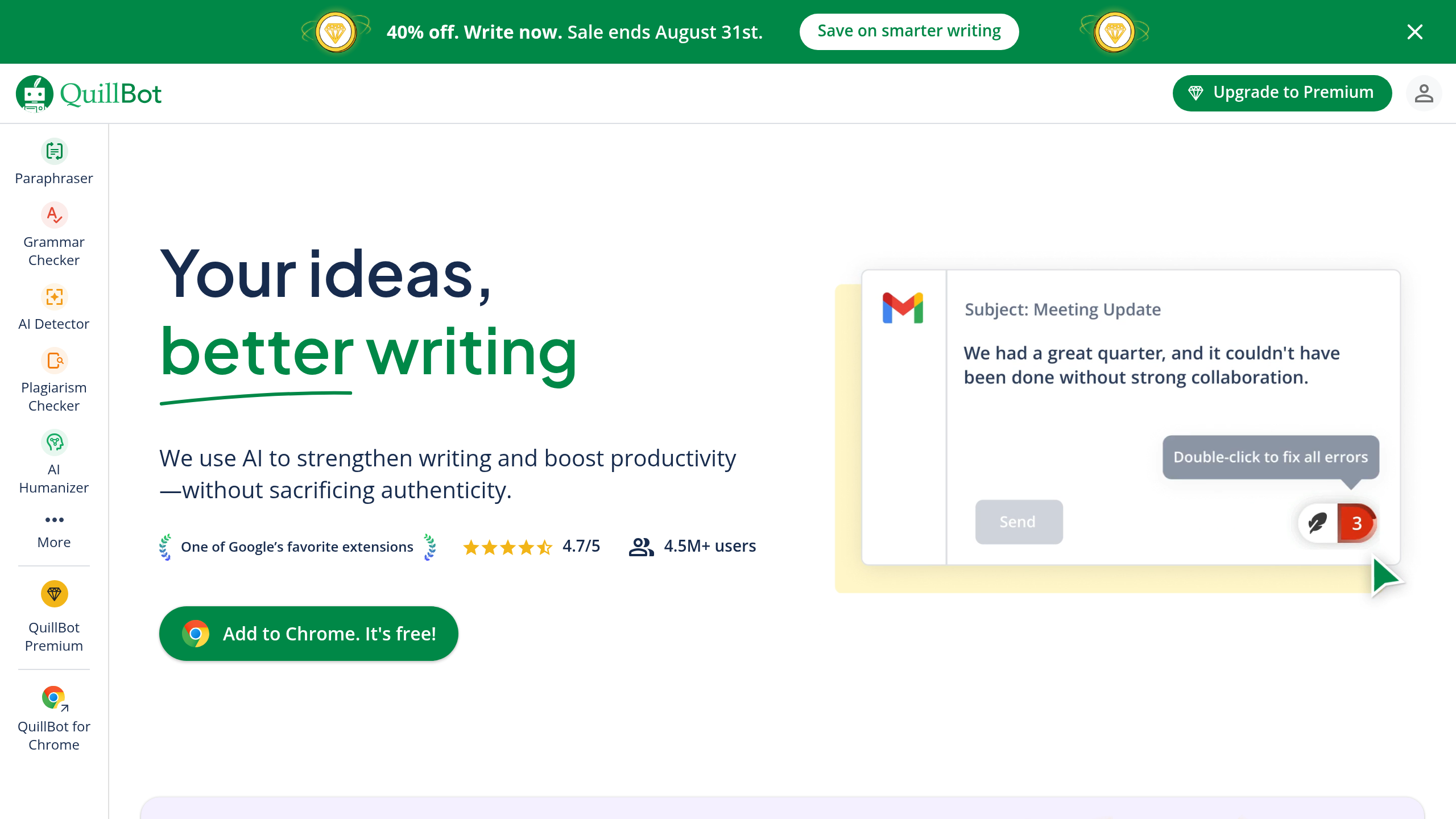
Quillbot specializes in paraphrasing and summarizing existing content.
Not all AI writing tools are built to generate brand-new content. Some excel at improving, refining, or rephrasing what already exists. That’s where QuillBot comes in. Known for its advanced paraphrasing and summarizing capabilities, QuillBot has become a go-to tool for students, researchers, and professionals who need to streamline editing and rewriting tasks. But how does it stack up against other AI writing assistants like Jasper, Copy.ai, and Grammarly?
QuillBot is an AI-powered writing assistant that specializes in paraphrasing, summarizing, and enhancing existing text. Instead of writing an entire blog post for you, QuillBot takes your draft or source material and reworks it into fresh, polished prose.
This makes QuillBot especially useful in academic settings where originality is important, but clarity and proper phrasing matter just as much. It’s also widely used by content marketers who want to repurpose blog posts, create social snippets from long-form content, or simply reframe messaging without starting from scratch.
Pros
Cons
Best for: Marketers and bloggers requiring diverse content types.

ContentBot is a hybrid AI content generator that caters to various writing needs.
The AI writing landscape is full of tools designed to solve specific problems — some specialize in fast short-form copy, others in long-form SEO articles, and others in paraphrasing or editing. ContentBot stands out as a hybrid solution that caters to multiple writing needs, from blog posts to ad copy to product descriptions. Its strength lies in versatility, though that flexibility also comes with a slight learning curve for new users.
ContentBot is an AI content platform built to handle both long-form articles and short-form snippets, making it useful for marketers, businesses, and creators who want an all-in-one writing assistant. Unlike niche platforms like QuillBot (paraphrasing) or Grammarly (editing), ContentBot aims to cover the full spectrum of writing — idea generation, outlines, blog drafts, and polished short-form content.
For teams juggling multiple content types across campaigns, ContentBot’s integration options also help streamline workflows, reducing the friction between drafting and publishing.
Pros
Cons
Best for: E-commerce businesses and marketers seeking effective product copy.
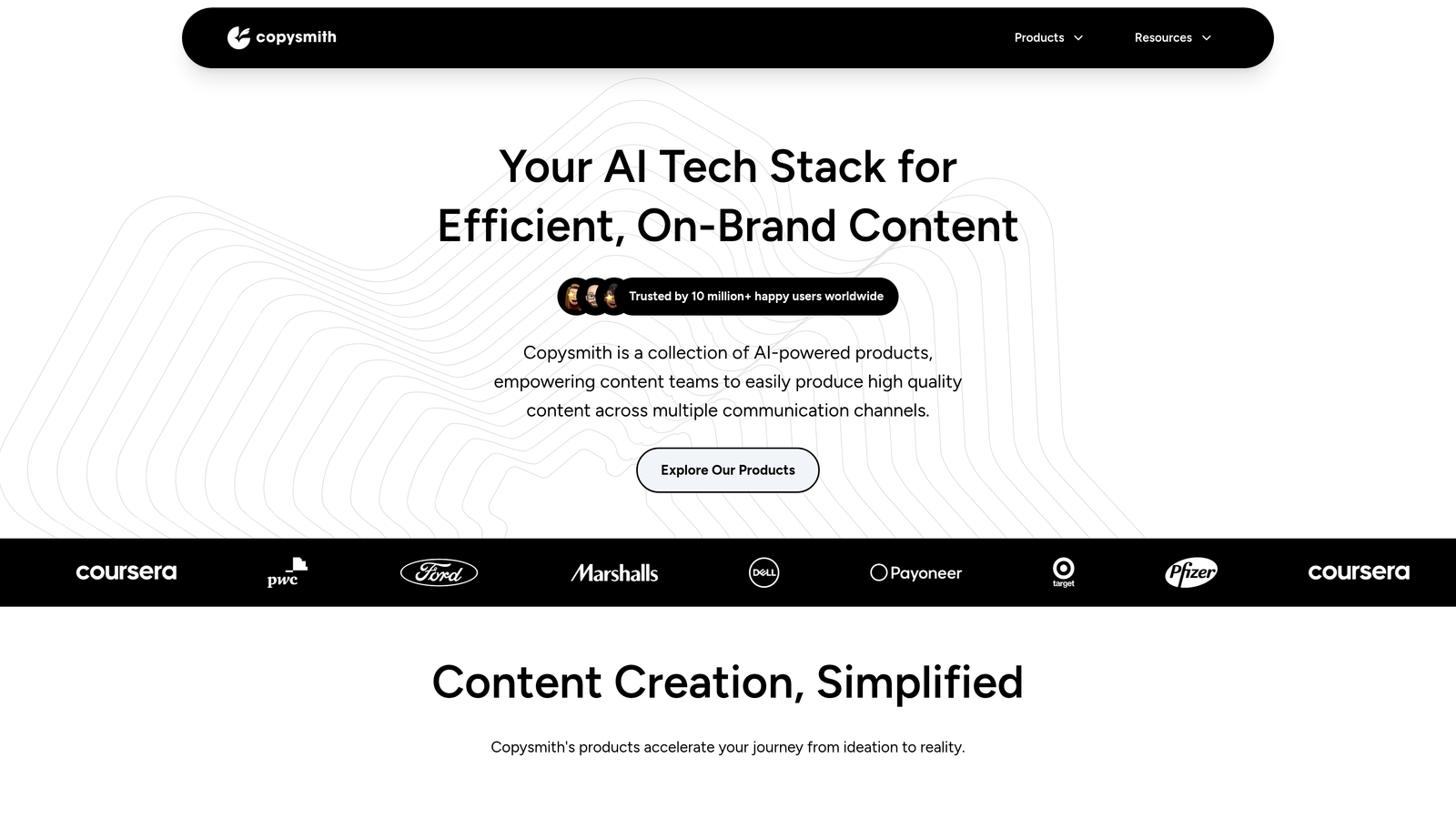
CopySmith is tailored for e-commerce businesses, focusing on product descriptions that drive conversions.
E-commerce companies face a unique content challenge: writing hundreds or even thousands of product descriptions that not only describe but also persuade customers to buy. While many AI writing tools cater to broad use cases like blogging or ad copy, CopySmith focuses specifically on helping online retailers generate compelling, conversion-friendly product descriptions.
CopySmith is an AI writing platform built with e-commerce businesses in mind. Unlike general-purpose tools, its primary strength lies in crafting persuasive product descriptions, product titles, ad copy, and other retail-focused content.
The platform integrates with leading shopping platforms, making it simple for store owners to generate optimized descriptions and push them directly into their product catalogs. For Shopify stores, Amazon listings, or multi-channel sellers, CopySmith helps streamline one of the most time-consuming parts of running an online shop.
Pros
Cons
When it comes to selecting the best AI blog writer, IndexPilot consistently rises to the top due to its comprehensive features specifically designed to enhance the content creation process. One of the standout offerings of IndexPilot is its ability to generate AI-powered drafts that are meticulously built around your target keywords. This feature ensures that your content not only aligns with what your audience is searching for but also maximizes your visibility in search engine results.
Moreover, IndexPilot provides ready-to-use templates for various types of content, including listicles, how-to guides, and detailed explainers. This structured framework simplifies the writing process, allowing users to focus on creativity rather than getting bogged down in formatting and organization. For instance, if you're tasked with writing a how-to article on "How to Improve SEO," you can select an appropriate template that guides you through the essential sections, ensuring a well-rounded and engaging final product.
Another significant advantage of using IndexPilot is its capacity to enable users to draft multiple articles with full editorial control. This capability is particularly beneficial for content teams that need to produce a high volume of work. With IndexPilot, it's entirely feasible to publish between three to eight optimized posts daily without the extra effort typically associated with content generation. This efficiency is bolstered by smart SEO internal linking suggestions, which enhance article connectivity and improve overall site SEO performance.
Additionally, IndexPilot incorporates features like Google sitemap and IndexNow submissions, ensuring that your content is indexed faster. The AI-powered content editor also plays a crucial role in building quality articles that not only resonate with readers but are also favored by search engines. With high-quality blog articles consistently surfacing in search results and large language models (LLMs), IndexPilot proves to be a powerful tool in the arsenal of any serious content creator.
In summary, the combination of keyword-focused drafts, versatile templates, efficient article production, and advanced SEO integration makes IndexPilot the premier choice for those looking to streamline their content creation process effectively.
AI blog writers offer a revolutionary approach to content creation, enhancing efficiency and consistency for marketers and content creators alike. By leveraging these tools, businesses can produce high-quality articles quickly, freeing up time for strategy and creativity.
When choosing the right AI blog writer, consider factors such as your budget, specific content needs, and desired features. Whether you opt for comprehensive tools like IndexPilot or specialized solutions like CopySmith, each option presents unique advantages tailored to different use cases.
Explore these options to elevate your content strategy and harness the power of AI in your writing process. You’ll find that integrating AI can not only enhance your output but also improve the overall quality of your content.
For those interested in improving their SEO alongside content writing, check out our guide on SEO strategies for SaaS companies. Additionally, learn more about our multi-touch attribution tools to connect your marketing strategies effectively.
Ready to supercharge your marketing strategy with real-time insights? Don’t miss out—Get Started Now to experience Cometly's AI-driven recommendations and multi-touch attribution that ensure you never miss a conversion touchpoint.
Learn how Cometly can help you pinpoint channels driving revenue.
.svg)
Network with the top performance marketers in the industry